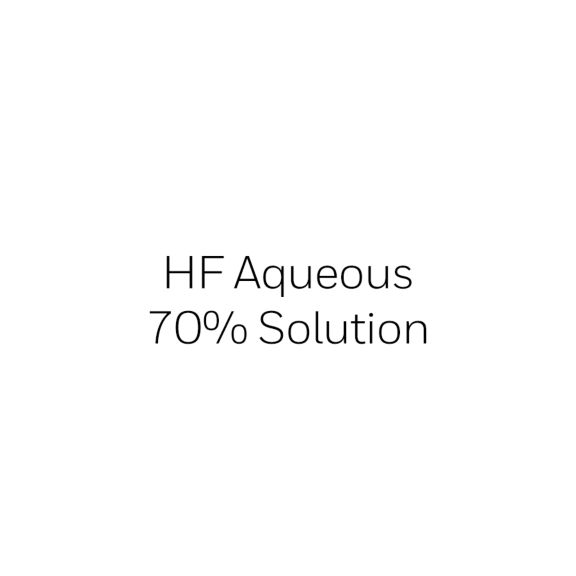Hydrofluoric Acid
Hydrofluoric acid (17870)
Aqueous 70% Solution
Please sign in to access more documents
Once signed in, you may be able to access additional documents for your account.
70% HF is highly hazardous and needs to be handled and used with rigorous safety precautions. It can cause severe burns to all parts of the body in liquid and vapor forms. Specialized medical treatment is required for any exposure to 70% HF.
General Information
- Application
- Chemical Derivatives
- Chemical Milling
- Glass Etching/Frosting
- Metal Pickling
- Quartz Purification
- Rare Metal Processing
- CAS Number
- Hydrofluoric Acid - 7664-39-3
- Water - 7732-18-5
- Concentration
- 30.00% water
- 70.00% HF acid
- Grade
- Aqueous 70% Solution
- Performance Function
- Feedstock
- Synonyms
- HF
- HF Acid
Physical Properties
- Boiling Point/Range
- 65 °C (1,013 hPa)
- Color
- Colorless
- Density
- 1.230 g/cm3 (20 °C)
- Flashpoint
- Not applicable
- Melting Point/Range
- -76 °C
- Odor
- Stinging
- pH
- Acidic
- Physical Form
- Liquid
- Solubility in Water
- Completely miscible
- Vapor Pressure
- 183 hPa at 21.1 °C(70.0 °F) hectopascal
Safety Information
- Chemical Stability
- Stable under normal conditions
- Corrosivity
- Corrosive to metals
- Ignition Temperature
- Not applicable
- Incompatible Materials
- Contact with alkalies and some oxides cause strong violent exothermic reactions
- Contact with metals will yield hydrogen gas, a fire and explosive reactive hazard
- Glass and silicate-containing materials are attacked
- HF contact with carbonates, sulfides and cyanides yield toxic gases such as carbon dioxide, hydrogen sulfide and hydrogen cyanide
- HF contact with glass, concrete and other silicon bearing
- On dilution or dissolving in water, considerable heating always occurs
- Pressure buildup from this process has been known to rupture glass containers
- When diluting, add acids to water, never the other way around
- Thermal Decomposition
- Fire or intense heat may cause violent rupture of packages.
International Transportation
- Chemical Class
- 8
- Harmonized System Code
- 28111100
- Packing Group
- I
- Sub Class 1
- 6.1
- UN Number
- 1790
General Information
- Application
- Chemical Derivatives
- Chemical Milling
- Glass Etching/Frosting
- Metal Pickling
- Quartz Purification
- Rare Metal Processing
- CAS Number
- Hydrofluoric Acid - 7664-39-3
- Water - 7732-18-5
- Concentration
- 30.00% water
- 70.00% HF acid
- Grade
- Aqueous 70% Solution
- Performance Function
- Feedstock
- Synonyms
- HF
- HF Acid
Physical Properties
- Boiling Point/Range
- 65 °C (1,013 hPa)
- Color
- Colorless
- Density
- 1.230 g/cm3 (20 °C)
- Flashpoint
- Not applicable
- Melting Point/Range
- -76 °C
- Odor
- Stinging
- pH
- Acidic
- Physical Form
- Liquid
- Solubility in Water
- Completely miscible
- Vapor Pressure
- 183 hPa at 21.1 °C(70.0 °F) hectopascal
Safety Information
- Chemical Stability
- Stable under normal conditions
- Corrosivity
- Corrosive to metals
- Ignition Temperature
- Not applicable
- Incompatible Materials
- Contact with alkalies and some oxides cause strong violent exothermic reactions
- Contact with metals will yield hydrogen gas, a fire and explosive reactive hazard
- Glass and silicate-containing materials are attacked
- HF contact with carbonates, sulfides and cyanides yield toxic gases such as carbon dioxide, hydrogen sulfide and hydrogen cyanide
- HF contact with glass, concrete and other silicon bearing
- On dilution or dissolving in water, considerable heating always occurs
- Pressure buildup from this process has been known to rupture glass containers
- When diluting, add acids to water, never the other way around
- Thermal Decomposition
- Fire or intense heat may cause violent rupture of packages.
International Transportation
- Chemical Class
- 8
- Harmonized System Code
- 28111100
- Packing Group
- I
- Sub Class 1
- 6.1
- UN Number
- 1790
- Synonyms : HF|HF Acid
- Grade : Aqueous 70% Solution
- Application : Chemical Derivatives|Chemical Milling|Glass Etching/Frosting|Metal Pickling|Quartz Purification|Rare Metal Processing
- CAS Number : Hydrofluoric Acid - 7664-39-3|Water - 7732-18-5
- Physical Form : Liquid
- Melting Point/Range : -76 °C
- Color : Colorless
- pH : Acidic
- Flashpoint : Not applicable
- Solubility in Water : Completely miscible
- Odor : Stinging
- Boiling Point/Range : 65 °C (1,013 hPa)
- Density : 1.230 g/cm3 (20 °C)
- Vapor Pressure : 183 hPa at 21.1 °C(70.0 °F) hectopascal
- Incompatible Materials : Contact with alkalies and some oxides cause strong violent exothermic reactions|Contact with metals will yield hydrogen gas, a fire and explosive reactive hazard|Glass and silicate-containing materials are attacked|HF contact with carbonates, sulfides and cyanides yield toxic gases such as carbon dioxide, hydrogen sulfide and hydrogen cyanide|HF contact with glass, concrete and other silicon bearing|On dilution or dissolving in water, considerable heating always occurs|Pressure buildup from this process has been known to rupture glass containers|When diluting, add acids to water, never the other way around
- Corrosivity : Corrosive to metals
- Chemical Stability : Stable under normal conditions
- Ignition Temperature : Not applicable
- Thermal Decomposition : Fire or intense heat may cause violent rupture of packages.
- Chemical Class : 8
- UN Number : 1790
- Sub Class 1 : 6.1
- Packing Group : I
- Harmonized System Code : 28111100
- Performance Function : Feedstock
- Concentration : 30.00% water|70.00% HF acid




